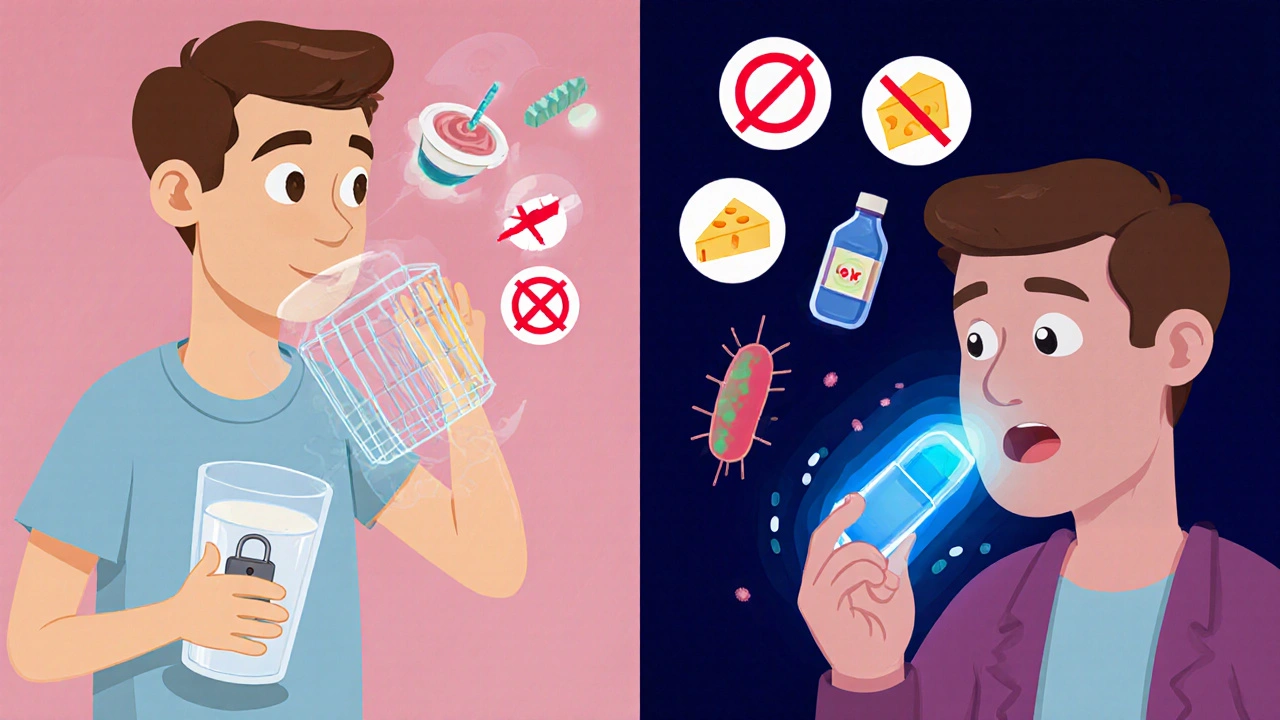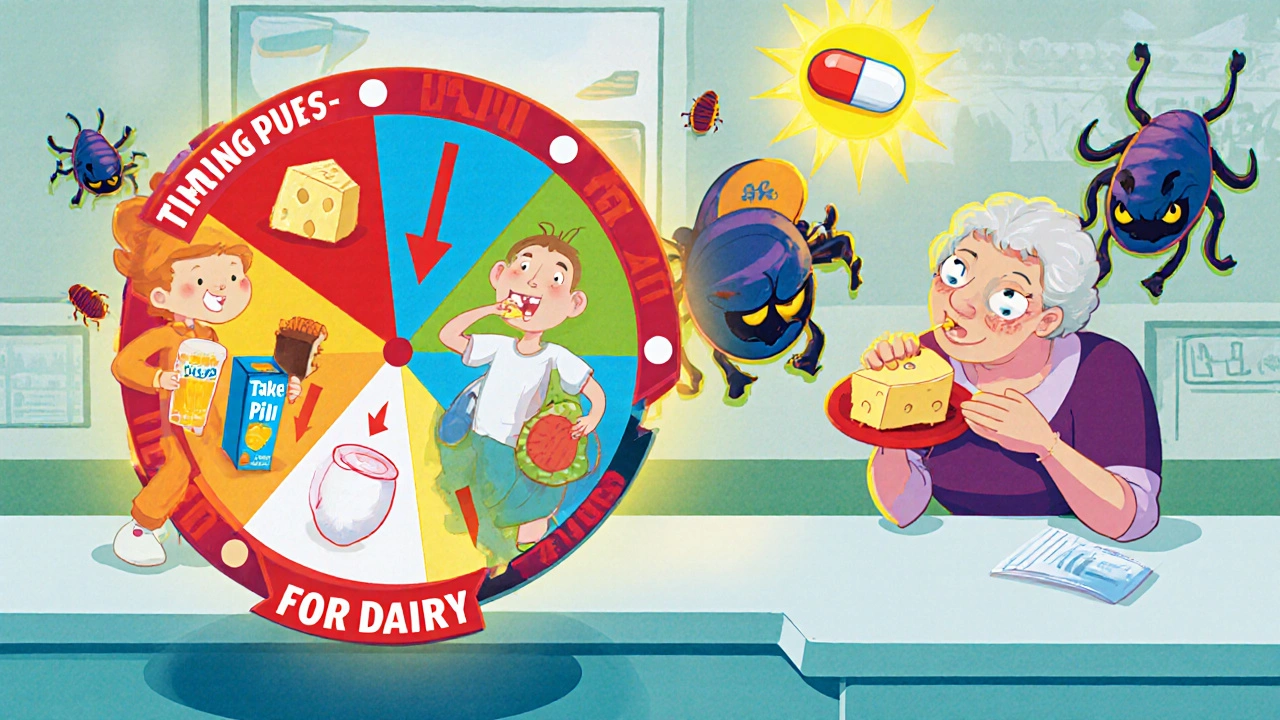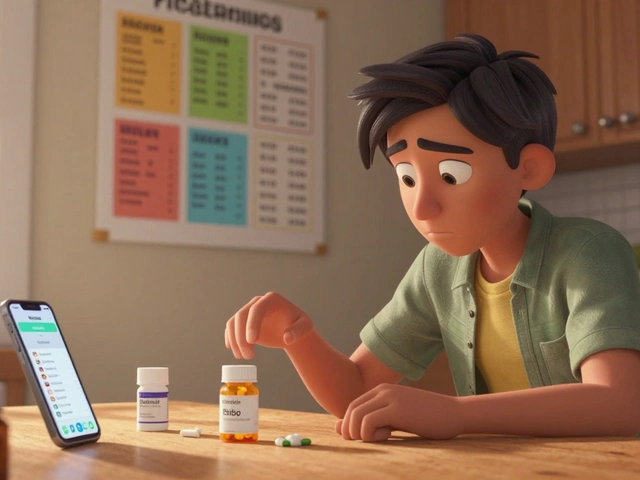Antibiotics and Dairy: Why Timing Matters for Drug Absorption

Antibiotic-Dairy Timing Checker
Select your antibiotic or enter its name to see if dairy products affect its absorption and how long you should wait.
Enter your antibiotic and click "Check Dairy Interaction" to see results.
When you take an antibiotic like doxycycline or ciprofloxacin, you might not think twice about grabbing a glass of milk or a bowl of yogurt. But that simple habit could be sabotaging your treatment. The calcium in dairy doesn’t just sit there-it actively binds to certain antibiotics in your gut, forming a compound your body can’t absorb. The result? You’re not getting the full dose. In some cases, you’re getting less than half.
How Dairy Blocks Antibiotics
The problem isn’t about digestion or stomach upset. It’s chemistry. Calcium ions in milk, yogurt, cheese, and even fortified plant-based drinks latch onto specific antibiotics like tetracycline, doxycycline, minocycline, ciprofloxacin, and levofloxacin. This binding creates a large, insoluble complex that passes through your intestines without being absorbed into your bloodstream. Think of it like putting a lock on the antibiotic-your body can’t pick it. This isn’t new science. Back in 1957, researchers first noticed that patients taking tetracycline didn’t improve as expected if they drank milk. Since then, dozens of studies have confirmed it. One study showed that taking tetracycline with milk cuts absorption by up to 75%. With yogurt? It’s even worse-up to 92% reduction in some cases. That’s not a small drop. That’s the difference between a treatment that works and one that fails.Which Antibiotics Are Affected?
Not all antibiotics react the same way. Some are barely touched by dairy. Others? They’re extremely sensitive.- Tetracyclines (tetracycline, doxycycline, minocycline): These are the most affected. Even a small amount of dairy-like a splash of milk in coffee-can cut absorption by 40% or more. Doxycycline is a bit less sensitive than older tetracycline, but it still needs space.
- Fluoroquinolones (ciprofloxacin, levofloxacin): These antibiotics also bind tightly to calcium. Ciprofloxacin’s absorption drops by 70% with milk and 92% with yogurt. That’s why doctors warn against taking these with dairy.
- Beta-lactams (penicillin, amoxicillin, cefalexin): Here’s the good news. Most penicillins and cephalosporins don’t interact significantly with dairy. You can take amoxicillin with breakfast. But cefalexin? It’s an exception-its absorption can drop by over 40% with milk.
How Long Should You Wait?
Timing isn’t optional. It’s critical. For tetracyclines, the rule is simple: take the antibiotic at least 2 hours before or 4 hours after consuming any dairy. Why the gap? It takes time for your stomach to empty and for the antibiotic to be absorbed before calcium enters the picture. Fluoroquinolones need at least a 2-hour window. That means if you take ciprofloxacin at 8 a.m., don’t have yogurt with your breakfast. Wait until 10 a.m. Or take it at 10 p.m., and avoid your bedtime snack of cottage cheese. But here’s where people get tripped up: it’s not just milk. It’s everything with calcium.- Milk (cow, goat, soy if fortified)
- Yogurt (even sugar-free or Greek)
- Cheese (hard or soft)
- Ice cream
- Cottage cheese
- Cream
- Butter (small amounts are usually okay, but don’t risk it)
- Whey protein shakes
- Calcium-fortified orange juice
- Antacids and calcium supplements

What About Dairy Alternatives?
Almond milk, oat milk, soy milk-many people assume these are safe. But they’re not always. Most store-bought plant-based milks are fortified with calcium to mimic dairy nutrition. That means they have the same problem. Check the label. If it says “calcium carbonate” or “tricalcium phosphate,” it’s a no-go during your dosing window. Unfortified almond milk? That’s usually fine. But it’s rare. Most brands add calcium for marketing. Don’t guess. Read the ingredients.Why This Matters Beyond Just Effectiveness
Failing to separate antibiotics from dairy isn’t just about a treatment not working. It’s about creating the perfect storm for antibiotic resistance. When you don’t get the full dose, bacteria don’t die completely. The survivors are the ones most resistant to the drug. They multiply. And now you’ve helped create a superbug. The World Health Organization estimates 1.27 million deaths a year are directly linked to antibiotic-resistant infections. That’s not a distant threat. It’s happening now. And simple mistakes-like drinking milk with your pill-contribute to it. Plus, there’s the cost. A failed course means another doctor visit, another prescription, more time off work. The U.S. healthcare system spends an estimated $1.3 billion annually treating infections that failed because of poor timing with dairy.What Can You Do?
Here’s a simple plan to avoid this problem:- Know your antibiotic. Check the label or ask your pharmacist: Is it a tetracycline or fluoroquinolone?
- Plan your meals. If you take your pill in the morning, have your dairy-free breakfast. Save yogurt for lunch or dinner.
- Use water. Always take antibiotics with a full glass of water. Avoid tea, coffee with milk, or juice with added calcium.
- Set reminders. Use your phone to alert you: “Take pill now. No dairy for 2-4 hours.”
- Ask your pharmacist. They can give you a printed timing chart. Many pharmacies now offer these at pickup.

Real Stories, Real Consequences
One patient on Reddit shared how she took doxycycline with her morning cereal and milk. She felt fine-until her acne flare-up returned worse than before. She had to restart the course. Another man took ciprofloxacin with his protein shake (which had added calcium). His urinary tract infection didn’t clear. He ended up in the ER with a kidney infection. On Drugs.com, users rate tetracyclines poorly for “ease of use,” with many citing the dairy restriction as a major hassle. One wrote: “I’d take my pill at 7 a.m. and couldn’t have coffee with milk until 11. I missed my whole morning routine.” But here’s the twist: people with lactose intolerance often do better. Their bodies naturally avoid dairy, so they’re less likely to accidentally ruin their treatment.What’s Changing?
Pharmaceutical companies are trying to fix this. Newer antibiotics like sarecycline (Seysara) are designed to bind less with calcium. Early data shows only an 8% drop in absorption with dairy-far better than older versions. Electronic health records now include alerts when a doctor prescribes a tetracycline. But only 62% of U.S. clinics use them. That means most patients still get no warning. The FDA requires all affected antibiotics to carry dairy interaction warnings on their labels. But patients rarely read them. Pharmacists are stepping in with visual “timing wheels” at the counter-color-coded charts showing when to take the pill and when dairy is safe.Final Rule: When in Doubt, Wait
If you’re unsure whether your antibiotic interacts with dairy, assume it does. Take it on an empty stomach with water. Wait 2 hours before eating anything with calcium. Wait 4 hours if it’s a tetracycline. It’s not about being perfect. It’s about being smart. Your body needs the full dose to kill the infection. Dairy doesn’t make your pill easier to swallow-it makes it useless. Don’t risk your treatment because of a habit you didn’t know was dangerous. One glass of milk shouldn’t cost you weeks of recovery-or fuel the next superbug.Can I drink milk with doxycycline?
No. Milk, yogurt, cheese, and other dairy products significantly reduce doxycycline absorption-by up to 50%. Take doxycycline at least 2 hours before or 4 hours after consuming dairy. Even a splash of milk in coffee can interfere.
What about almond milk or oat milk?
Most store-bought almond and oat milk are fortified with calcium, which causes the same interaction as dairy milk. Always check the ingredient label. If it contains calcium carbonate, tricalcium phosphate, or calcium phosphate, avoid it during your dosing window. Unfortified versions are usually safe, but they’re rare.
Is it okay to take antibiotics with yogurt?
No-not if you’re taking tetracycline or fluoroquinolones. Yogurt has higher calcium bioavailability than milk, meaning it blocks absorption even more. In some studies, yogurt reduced ciprofloxacin absorption by 92%. Save yogurt for later in the day, after your 2- to 4-hour window.
Which antibiotics can I take with dairy?
Most penicillins like amoxicillin and ampicillin, as well as azithromycin, can be taken with dairy without affecting absorption. Some cephalosporins like cefdinir are also safe. But cefalexin is an exception-it’s reduced by over 40%. Always check your specific antibiotic’s label or ask your pharmacist.
What if I accidentally take dairy with my antibiotic?
If you accidentally take dairy with your antibiotic, don’t panic. Don’t double the next dose-that can be dangerous. Just take your next scheduled dose as normal, and avoid dairy until after that. One slip-up won’t ruin everything, but repeated mistakes can lead to treatment failure. Talk to your doctor if you’re unsure.
Why does calcium interfere with antibiotics?
Calcium ions in dairy bind chemically to antibiotics like tetracycline and ciprofloxacin, forming large, insoluble complexes in the gut. These complexes can’t be absorbed into the bloodstream, so the antibiotic passes out of your body unused. This process is called chelation and happens within minutes of ingestion.
Can I take antacids with antibiotics?
No. Antacids contain calcium, magnesium, or aluminum-all of which interfere with antibiotic absorption. If you need an antacid, take it at least 2 hours before or 4 hours after your antibiotic. Same rules apply as with dairy.
How long does it take for an antibiotic to be absorbed?
Most antibiotics are absorbed within 1-2 hours after taking them on an empty stomach. That’s why you need to wait at least 2 hours before eating dairy. Waiting 4 hours ensures your stomach has fully emptied and the antibiotic is already in your bloodstream.
Does the timing matter if I have a mild infection?
Even for mild infections, incomplete dosing can allow bacteria to survive and develop resistance. While you might feel better temporarily, the infection could come back stronger. For serious infections like Lyme disease or Rocky Mountain spotted fever, getting the full dose is critical-missing even 20% can be life-threatening.
Are there new antibiotics that don’t interact with dairy?
Yes. Newer drugs like sarecycline (Seysara) and doxycycline monohydrate (Oracea) are designed to bind less with calcium. Sarecycline shows only an 8% drop in absorption with dairy. But these are still exceptions. Most antibiotics on the market today still interact with dairy, so timing remains essential.






Linda Rosie
November 21, 2025 AT 23:11Interesting read. I always took my doxycycline with breakfast and never thought twice about it. Now I’m rethinking my whole morning routine.
Thanks for the clarity.
Ross Ruprecht
November 23, 2025 AT 08:41Ugh. So now I can’t have my yogurt smoothie with my antibiotics? This is why I hate following medical advice. Just give me the pill and let me live.
Also, why is everyone so obsessed with dairy? It’s just milk.
Bryson Carroll
November 24, 2025 AT 12:11Wow another one of those ‘don’t drink milk with your meds’ posts that treat patients like toddlers. The science is real but the tone is infantilizing. You don’t need to scare people with superbugs every time you mention calcium chelation. It’s chemistry not a horror movie. Also, who even eats yogurt at 7am anymore? This article reads like a pharmaceutical ad disguised as public health advice.
Also the part about plant milks? Please. Most people don’t even read labels. You’re preaching to the choir.
Jennifer Shannon
November 25, 2025 AT 19:35This is such a beautifully detailed breakdown - thank you for taking the time to lay it out so thoroughly. I’ve been on antibiotics before and never realized how much the calcium in my oat milk was interfering - I just assumed ‘plant-based = safe’. Turns out, nope. I now check every label like a hawk. And honestly, the part about antibiotic resistance? That hit me in the chest. It’s not just about me, it’s about everyone else too - the grandma in the ICU, the kid with strep throat, the nurse who might get infected by a superbug we helped create by being careless. I used to think these little habits didn’t matter, but now I see how they ripple out. I’m printing out the timing chart and putting it on my fridge. Also, I love that you mentioned lactose-intolerant people having an accidental advantage - that’s such a sweet, unexpected twist. The world is weird and wonderful.
Also, I’m now considering switching to unfortified almond milk just for this reason - even if it costs more and tastes like cardboard. Worth it.
Suzan Wanjiru
November 26, 2025 AT 11:04For anyone taking cipro or doxy - water only. No coffee with cream. No protein shakes. No orange juice with added calcium. That’s it.
Pharmacists can give you a free timing card. Ask for it.
Don’t guess. Just do it.
Kezia Katherine Lewis
November 28, 2025 AT 07:19Chelation dynamics are not trivial in pharmacokinetic profiles. The divalent cation interaction with 4-quinolone scaffolds significantly alters bioavailability metrics, particularly in the duodenal microenvironment. This is well-documented in the 2018 Journal of Antimicrobial Chemotherapy meta-analysis. Moreover, the clinical implication extends beyond therapeutic failure into the realm of selective pressure-driven resistance emergence. The public health burden is non-trivial. I recommend integrating this into patient counseling protocols with visual aids - timing wheels are underutilized. Also, fortified plant-based beverages are a regulatory blind spot - labeling should be standardized. The FDA needs to mandate clearer front-of-package indicators for calcium content in non-dairy alternatives. This isn’t just a patient education issue - it’s a systems failure.
Henrik Stacke
November 29, 2025 AT 20:11Oh my goodness, I had no idea. I’ve been taking my cipro with my morning latte for years. I just thought I was being efficient. Now I feel like a complete idiot - and also slightly guilty. I’ve probably been helping superbugs win. This is the kind of thing you hear about in documentaries and think ‘that’ll never be me’ - until it is. Thank you for this. I’m going to start carrying a little note in my wallet: ‘No dairy. No cream. No protein shake. Water only.’ I’m not perfect, but I’m trying. And I’m telling everyone I know. This is important.
Manjistha Roy
November 30, 2025 AT 16:05As someone from India where dairy is part of daily life, I’ve seen many people struggle with this - especially when they’re prescribed antibiotics after a fever or infection. In our culture, milk and yogurt are comfort foods. It’s hard to tell someone not to have their morning lassi or evening curd rice. I’ve started making simple infographics for my family and friends - one page, two columns: ‘Safe’ and ‘Not Safe’. I even added pictures of common foods. It’s not just about science - it’s about culture. We need more culturally adapted education, not just clinical warnings. Also, many elderly people don’t read labels. They trust brands. We need community health workers to help bridge this gap. Thank you for writing this - it’s a start.
Jennifer Skolney
December 1, 2025 AT 07:10I used to mix my doxycycline with my protein shake because I hate swallowing pills dry. Then I got a UTI that wouldn’t go away. Turns out the shake had calcium carbonate. My doctor was like, ‘Ohhh that’s why.’ I felt so dumb. Now I keep a little water bottle next to my meds. And I say ‘nope’ to dairy like it’s a bad date. 🙃
Also - if you’re on doxycycline and you’re not sure, just wait 4 hours. It’s easier than restarting the whole course.
JD Mette
December 3, 2025 AT 02:09My mom took doxycycline for Lyme disease and accidentally had yogurt with it. She didn’t realize the infection came back worse. She’s fine now, but it was scary. I’m glad this got shared. It’s one of those things no one talks about - until it’s too late. I’m going to print this out for my family. Thanks for the reminder.